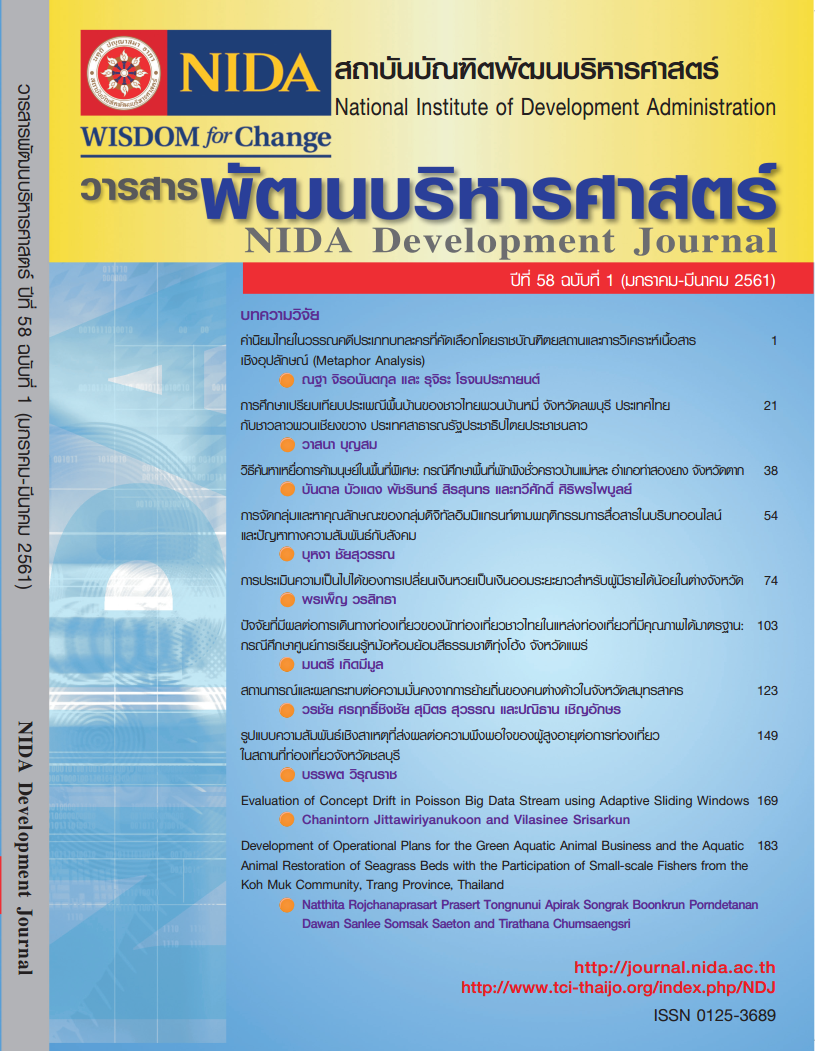Cluster Analysis of Digital Immigrants based on Online Communication Behavior and Social Relationship Problems
Main Article Content
Abstract
The research objectives are (1) to study the online communication behavior of digital immigrants (2) to cluster the group of digital immigrants and (3) to identify the social relationship problems. The online questionnaire survey with a total of 400 digital immigrants was used as the data collecting method.
The findings show that most of the digital immigrants use online communications on a daily basis consisting of searching information, chatting and keeping themselves updated about their friends' activities as well as the entertainment news. Besides, the most popular applications are LINE, Facebook, and YouTube. The Digital Immigrants are divided into 4 groups by K-Means Clustering Analysis, namely “Communication for wisdom”, “Communication is life”, “Peaceful and happy alone” and “Minimal communication”. The group of “Communication is life” spends the highest amount of communication time online; thereby, this group gets the highest probability of social relationship problems, such as internet addiction and loneliness. Nonetheless, this group still believes that they would receive social support when in needed.
Article Details
References
Brenner, V. (1997). Psychology of computer use: XLVII. Parameters of Internet use, abuse and addiction: The first 90 days of the Internet usage survey. Psychol. Rep.80: 879–882.
Brooks-Young, S. (2005, January-February). Integration issues for 21st -century teachers. Today’s Catholic Teacher. Retrieved January 15, 2014 from https://www.peterli.com/archive/tct/790.shtm.
Bucher, E., Fieseler, C., Meckel, M., & Suphan, A. (2011). Social Media and the Communication Profession. Retrieved January 17, 2014 from https://www.alexandria.unisg.ch/publications/citation/Anne_Suphan/91164.
Daenkrung, Supatat. (2012) Relationships between behavior of Internet addiction with loneliness and social skills of teenagers: a case study of Mathayom Suksa students in the Upper Northern Region. Chiang Mai: Graduate School Chiang Mai University. (In Thai)
Department of Mental Health, Thailand (2012). Manual of five dimensions of happiness for the Elderly. Bangkok: Beyoind Publishing Co,.Ltd.
Douglas A. Gentile, P. J. L., Jennifer Ruh Linder, David A. Walsh. (2004). The effects of violent video game habits on adolescent hostility, aggressive behaviors, and school. Journal of Adolescence, 27: 188-195.
Edward Shih-Tse Wang and Michael Chih-Hung Wang. (2013, November). Social Support and Social Interaction Ties on Internet Addiction: Integrating Online and Offline Contexts. Cyberpsychology, Behavior, and Social Networking, 16(11), 843-849.
Electronic Transactions Development Agency (Public Organization), ETDA. (2014). Thailand Internet User Profile 2014. Bangkok. Retrieved January 17, 2014 from https://www.slideshare.net/Yakuzaazero/2557-37727346.
Gerrit Stols. (2008). African Journal of Research in Mathematics, Science and Technology Education. Retrieved January 17, 2014 from https://scholar.google.com/citations?view_op=view_citation&hl=hr&user=MMubJYoAAAAJ&citation_for_view=MMubJYoAAAAJ:Y0pCki6q_DkC.
Grusser S. M., Thalemann R., Albrecht U., Thalemann C. N. (2005). Excessive computer usage in adolescents-a psychometric evaluation. Wiener Klinische Wochenschrift
International Telecommunication Union. (2008). ITU Corporate Annual Report. Retrieved February 10, 2014 from https://www.itu.int/osg/csd/stratplan/AR2008_web.pdf.
Jengchung V, Chen Charlie C and Chen Hsiao-Han Yang. (2008). An empirical evaluation of key factors contributing to internet abuse in the workplace. Industrial Management & Data Systems, 108(1), 87–106.
Kaewkungwarn,. Srireon. (1995). Psychology Development for all ages.(6th Edition) Bangkok: Thammasart University. (In Thai)
Kaewthep, Kanjana . (1998). Mass communication: Theories and methods. Bangkok: Paabpim Printing.
Kandell, J. J. (1998). Internet addiction on campus: The vulnerability of college students. Cyberpsychol. Behav, 1(1), 11–17.
Knobloch-Westerwick, S. (2007). Gender differences in selective media use for Mood Management and mood adjustment. Journal of Broadcasting & Electronic Media, 51(1), 73–92.
Kruistum, Claudia van, et,al. (2014). Youth Media Lifestyles. Human Communication Research. Retrieved January 17, 2014 from https://onlinelibrary.wiley.com/doi/10.1111/hcre.12033/abstract.
Marc Prensky. (2001). Digital Natives, Digital Immigrants Part 1. On the Horizon. 9(5), 1–6.
Mark Griffiths. (2010). Internet abuse and internet addiction in the workplace. Journal of Workplace Learning, 22(7), pp.463-472. Retrieved January 17, 2014 from https://dx.doi.org/10.1108/13665621011071127.
Mindshare Thailand. (2014, June 13). Growing Up as Digital Natives [Blog]. Retrieved January 17, 2014 form https://www.mindshareworld.com/thailand/news/mindshare-thailand-reveals-online-behavior-and-motivation-digital-natives. (In Thai)
National Statistical Office. (2014). A survey of owned and usage of Information technology and communication in household. Retrieved January 17, 2014 from https://service.nso.go.th/nso/web/survey/surtec5-1-3.html. (In Thai)
Nowwarat Loungon (2008). The effect of Computer usage towards University students’ health-related behaviors. Thesis. Bangkok: Graduate School, Srinakharinwirot University.
Pattariga Wonganantnont (2014). Excessive Internet Usage Behavioral in Adolescents. Journal of the Royal Thai Army Nurses. 15(2 ) 2014: 173-178.
Pelzer,K. (2009). Patient experiences and health system responsiveness in South Africa: Health Serv Res. BMC Health Services Research, 9: 117. doi:10.1186/1472-6963-9-117.
Prajongsaengsri, Kanokkarn. (2010). Baby Boomers are booming. Retrieved January 17, 2014 from https://www.positioningmag.com/content/ Baby Boomers are booming. (In Thai)
Prasit-rathasint, Suchart. (1997). Research Methods for Social Sciences. Bangkok: Liang Chiang Publishing Co.,Ltd. (In Thai)
Sarah Ransdell, Brianna Kent, Sandrine Gaillard-Kenney andJohn Long. (2011). Digital immigrants fare better than digital natives due to social reliance [Blog]. Retrieved January 17, 2014 from https://onlinelibrary.wiley.com/doi/10.1111/j.1467-8535.2010.01137.x/abstract.
Scherer, K. (1997). College life online: Healthy and unhealthy Internet use. J. College Stud, 38(6), 655–665.
Sinnititaworn, Tippawan.(2010). Generation X. Retrieved January 17, 2014 from https://sites.google.com/site/490880tippawansinnititaworn/ examinatio/generation-x. (In Thai)
Siriboon, Siriwan and Milintangul, Chanettee. (2008). The elderly. College of Population Studies: Chulalongkorn University. Retrieved January 17, 2014 from https://www.cps.chula.ac.th/cps/research_division/article_ageing/ageing_001.html (In Thai)
Sukhothai Thammathirat Open University. (2016). Aging society: the Economic Development. Retrieved January 17, 2014 from https://www.stou.ac.th/stouonline/lom/data/sec/Lom12/05-04-02.html.
Thongkambunjong. Wailailak. (2010). Causal Factors of Internet Dependency Behavior of High School Students in Bangkok Metropolis. Dissertation. Bangkok: Graduate School, Srinakharinwirot University. (In Thai)
Walker, B. (2012). Digital Immigrants: An Exploration of Their Technological Knowledge and Skill Sets. (Ph.D. Dissertation). Drexel University, Philadelphia.
Wanitbancha, Kanlaya. (2009). Statistics for Research (4th Edition). Department of Statistics, Faculty of Commerce and Accountancy: Chulalongkorn University. (In Thai)

